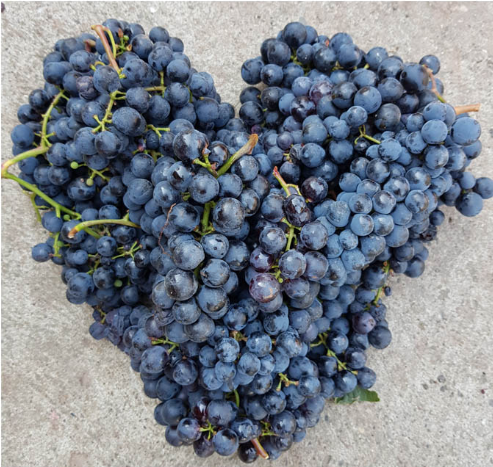Crop: Vitis vinifera L. (Grape vine)
Seduša is cultivated in northern Serbia, on northern slopes of Fruška gora, an island mountain in the Pannonian Plain, on the steep hillsides of the village Banoštor (the Srem wine region). From the historic resource archimandrite, Prokopije Bolić in his book ‘Soveršen vinodelac’ (Perfect winemaker, 1816) first time mentions and describes the landrace Seduša.
Sedusha is a sensitive grape landrace characterized by medium-sized, thin skinned berries. It can accumulate high levels of sugar in good years. It usually matures between the third and fourth epoch of maturation. Seduša is generally characterised by high yield, so the key factor affecting the quality of wine making is to severely limit the yield by removing 50-60% of the clusters of green pruning. Variety identification is finished by molecular marker at Consiglio Nazionale delle Ricerche, Istituto per la Protezione Sostenibile delle Piante (Unit of Grugliasco, Torino, Italy 2009).
Pruning system is hard to define, it is combination of Guyot, double Guyot and Royat.
Cultivation System: ND.
Geographical Information
Country: Serbia
Seduša is traditionally cultivated in the village of Banoštor (Banostor is a village in Serbia in the municipality of Beocin in the South Backa District). The landrace is cultivated in very small vineyards, for a total of a less than 1 hectare. The fields are located in the upper part of the land belonging to the municipality at 125 m a.s.l. The other not so clear evidence reports the presence (not far in the past) of the landrace in village Divoš that is also in the Srem wine region, 20 kilometres from Banoštor.
Farmer(s) description:
After the phylloxera plague, many old varieties were neglected and abandoned due to the introduction of internationally recognised varieties, as well as changing the system of cultivation. Seduša was rediscovered in 2009.
Currently, Seduša is only used by a single small winery, cultivated on an area of circa one hectare. Provincie of Vojvodina, within its subsidies, recognised the importance of landraces, so that it provides funds for co-financing the costs of introducing and certifying the system of safety and quality of food and products with geographical designations. In 2019, new potential producers were encouraged through the above-mentioned system of subsidies.
Propagation system: Clonal
Multiplication procedures and consequences on landrace diversity:The landrace management relies completely on activities of producers in the area.
Management plan existence:ND.
Added Values
Seduša is a delicate vine variety characterized by medium-sized, thin skinned berries. It can accumulate high levels of sugar in good years. It matures between the third and fourth epoch. The variety is quite yielding; however, the key to achieve high quality limits the yield; usally 50-60% of the clusters are rmoved during green pruning.
The resulting wine is characterised by a light ruby colour, with a lot of earthy and mineral tones, while, at the same time, fruity with clear aromas of currants and cherry plum. The resulting wine is quite high in alcohol content that does not interfere with the balanced aromas.
Currently, for Seduša wine there is a much higher demand than production. As it is a limited production, about 3000 litres per year, Seduša wine is mainly marketed in the Province of Vojvodina, in the Srem region.
By the latest government measures, there is enough capacity's for the increase surface under this variety.
Others (e.g. commercial/geographical brands or special traits):In 2019. year, 5 clones of Seduša were registered in National catalogue of agricultural varieties. The standard samples are maintained in Institute for winegrowing, which is held at the Agriculture college in Novi Sad. http://www.sorte.minpolj.gov.rs/sites/default/files/rsprilogom_3.pdf.
Ministry of agriculture, forestry and water management under the measures of rural development, made two strategic regulations to foster the use of Seduša as well as other landraces:
1. Rulebook on incentives for production of planting material and certification and clonal selection of fruit trees, vines and hops.
This impetus measure is a made for science research institutes and their work in rural areas, abandoned vineyards and fruit yards on rediscovering traditional landraces and historical varieties. Their work also covers processing of plants virus sanitations, certification and promotions. The measures can support actions up to 85.000,00 euro.
2. Rulebook of support for the raising of new plantations of fruit, vines and hops.
Even if this measure is made for all varieties it gives extra support to traditional varieties, landraces and historical varieties, especially in rural area. Currently, the measure can provide up to 25.000,00 euros per hectare.
This landrace and its product have a good value as an authentic product linked with the cultural heritage of the area in which it is cultivated.
Uncertain. Access to the resource and clones visit : http://www.sorte.minpolj.gov.rs/sites/default/files/rsprilogom_3.pdf
Case study provided by Аleksandar Tabaković, adviser for registration of fruit and grape varieties, Ministry of agriculture, forestry and water management Belgrade, Serbia.
Most of updates have been communicated by Dr Bojan Mandić.
- State support for financing vineyard development, production of wine and wine tourism in Serbia Gordana Radovic, prof. Zorica Vasiljevic, prof. Radovan Pejanovic. Federal agro-mediterranean office, Mostar faculty of agriculture and food and technology, Universities in Mostar ‘130 years of being organized viticulture and winemaking in Bosnia and Herzegovina, Mostar, 21/22. september 2018.
- Domestic and old adopted grapevine cultivars in Fruska Gora wine area region, Korać Nada, Cindrić P., Paprić đ., Kuljančić I., Medić Mira, Ivanišević D., Božović P., Journal of Agriculture ‘Contemporary agriculture’, Novi Sad 2007.
- On-farm inventory of minor grape varieties in the European Vitis Database, Report of Serbia, GrapeOnFarm 2017 Serbia 2 – ECPGR, Dragoslav Dragoslav Ivanišević and Dragan Nikolić.
- Clonal selection of the Seduša variety, Dr Bojan Mandić, Scientific and professional conference ‘Innovations in viticulture’, Faculty of Agriculture Novi Sad, 2018.
